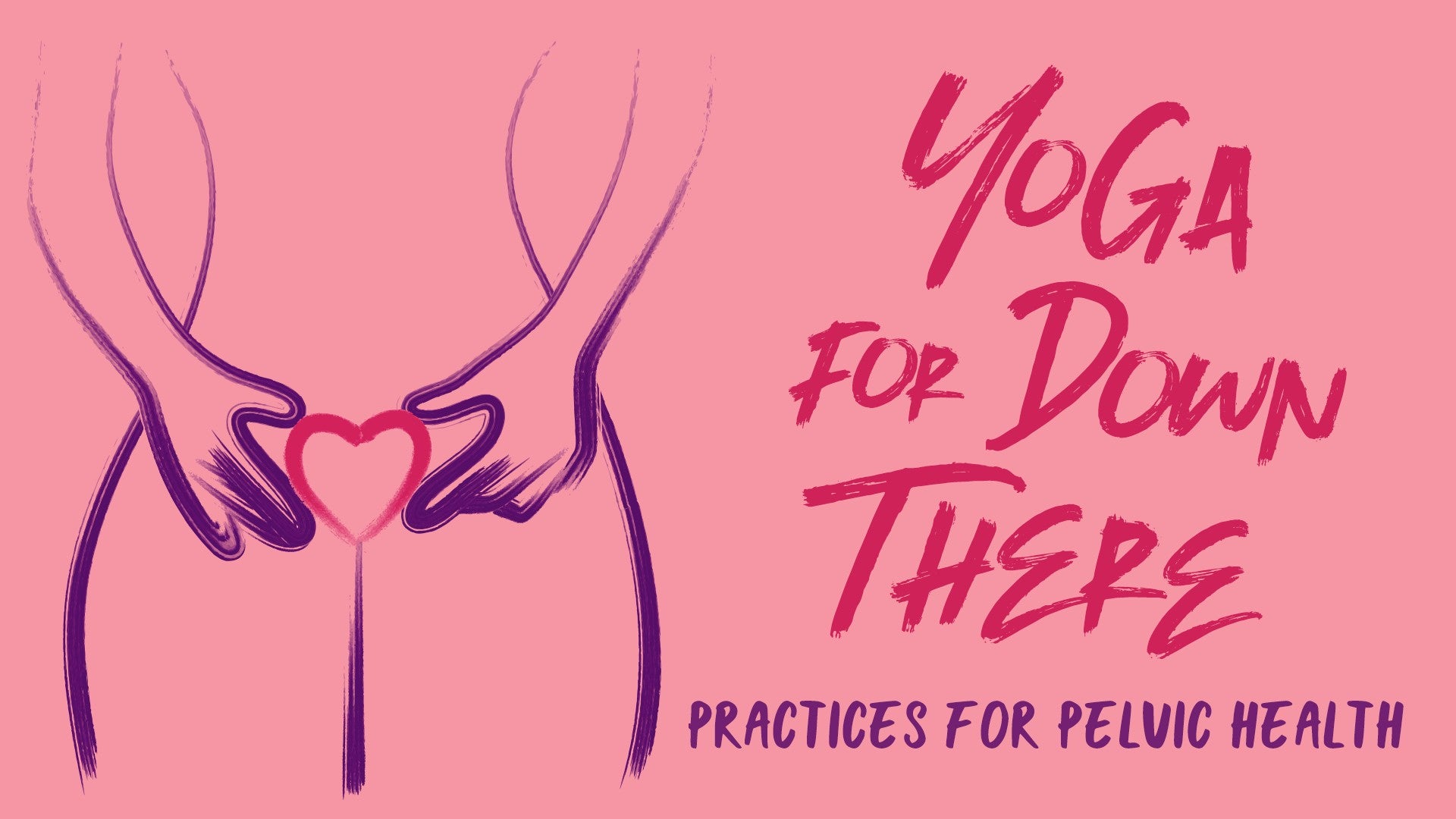Description
About This Video
Transcript
Read Full Transcript
Welcome, here are some of my favorite variations of bird-dog pose, and these really help to get into the core fours, the transversus abdominis muscles, the multifidus muscles, and when we use continuous breath in the diaphragm and pelvic floor. You're going to want to have a wall nearby for a couple of the poses, and if you have a ball as well, bring that with you. If not, there's just one pose in there, and that's okay, we can modify that as we go. So we'll come into table, close to the front of your mat, leave some space between yourself and the wall. So we're going to stretch out on the exhale here.
So we'll take our inhale at table, and on the exhale, stretching out the left foot back behind, and then the opposite hand. So for me, it's my right hand, stretching out, that's our exhale. On the inhale, come back to table, see if you can lengthen the spine on the inhale. Exhale and stretching the hand forward, stretching the foot back. Inhale coming back to table.
And finding the breath that works for you here as you exhale, stretching out, opposite hand, opposite leg, inhale coming back to center, exhale stretching opposite hand, opposite leg. And we'll do one more time each side, and the exhale moving, inhale coming back to table, exhale stretching opposite hand, opposite leg, and inhale coming back to center, excellent. Then we'll move back so that the foot will touch the wall, you might have to play around with and find where is the wall. And once we've kind of measured that leg length, and we feel like that's our leg length, we're gonna move back out of that, back into table. From here, really lengthen through the spine, so imagine that you're growing tall out through the crown of the head.
Take an inhale here, and on the exhale, extend one leg back towards the wall, and notice what happens, so right away I feel a real shift for the body, it tries to level out and it leans a little bit over to my opposite side. So see if you can push your foot into the wall, and you might even look back and see are the toes pointing down, is my leg in line with the spine, can I push away from the floor with my arms evenly? Continuous breath here, lengthen through the spine, amazing, notice if you start to hold the breath, and if you want to then you can extend the opposite arm out, but just really noticing when you go to do that, does it feel like you're as stable or are you going to stay here with both hands planted, and if we want we might reach out, continuous breath, lower the hand down when you're ready, lower the knee down, come back to table, find the breath here, and then we'll do the other side and find out if one leg is longer than the other one today. So we'll look back, you can either look underneath the body or look back over the shoulder, check in that the length is there, then we'll lower the knee down, and we're going to raise the foot up nice and slow. So it might be on the exhale where we exert the effort, that might help us move a little bit, might help us a little bit more.
So on the exhale, bring that foot back to the wall, continuous breath there, notice and see if you can push yourself away from the floor with the hands, find the strength in the arms, and at the same time lengthen the spine, so grow really tall. And then maybe opposite hand reaches forward, but if it feels like then I can't breathe, I couldn't sing a song here, I couldn't talk, then we're going to lower that hand down. And so when you're ready, lowering that hand down slowly, lowering the knee down, coming back to table, connecting with the breath, great. So the next place that we're going to move to is using the ball if we have one, and if not we can come back to that version of bird dog there with the foot against the wall, that might be helpful. When you're using the ball, just no permission to be wobbly is here and will go really slow.
So I like to bring my feet to the wall, my toes to the wall in this just to feel their support and then roll over the ball really slowly. So your ball might be a different size as well. And right here it gets pretty wobbly right away. So this might be your version of bird dog at the wall with the ball, say that six times fast and then we'll start to see if we can bring the right foot up a little bit or the left foot. One foot lifts up a little bit and length through the spine is what we're going for here.
That's what it might be, we feel like opposite hand can reach forward, it might help to look forward. And then remembering to breathe, that's what I feel like I'm forgetting here. And then lowering the hand down, slowly lower the foot down. And then getting set up for the other side, but let's see if we can focus on the breath here for a moment. If ever this feels uncomfortable, then we'll come back to one of the previous versions of bird dog.
So we can inch the foot up slowly. The side feels more difficult in my body, so that's a good place to notice. Is the side feeling different? Can I still breathe here? Breathing through the foot into the wall might help, and then lengthening the opposite arm if you would like to.
Great, that's fantastic. And then slowly rolling off the ball, bring the ball to the side, and we'll do one of my favorite versions of bird dog, which is reclined. So lowering down to the floor, find lots of length here. So this is where we have the alignment piece, where we check in is pelvis at neutral. That helps the transversus abdominis muscles to engage.
And this alignment is pretty natural because the floor is there to help us with it. So if we imagine that we just took that pose and we flipped it right over, that's what we're going to do. So one leg is extended. That one seems really easy now in this version before that was harder. And the other knee is bent.
So for me, I have my left knee bent, the right leg is extended. So the opposite arm is going to extend out to straight. So my left arm is extending out to straight, and my right arm is planted on my imaginary, what was the floor, and now is the sky. So we take an inhale here and we're going to switch. And don't worry if this feels really confusing for the brain.
That's the bonus of this one. So we take an inhale and we're ready to switch, we're going to exhale. So on the exhale we lower the left leg down, the left hand comes up towards the sky, the right arm extends out to straight, the right knee is bent. Take an inhale here, and on your next exhale then we're going to switch. And what happens to the brain is really fun.
The brain forgets. Which way is that hand going? They both want to do the same thing. So we're making new pathways in the brain as we go. So imagine that you're in that bird-dog pose when you get to that exhale.
And one of the most important things is if we get mixed up, and we're not sure which hand is moving in which direction, we just say, so what, at this point. So it's opposite arm extends as opposite leg extends. That's mainly what we're going for here. Good, and then one last one. And lowering both feet down to the floor, knees might be bent or legs extended.
We're going to enjoy a nice well-deserved relaxation. So maybe lengthening through the heels, wiggle around, find a comfortable spot. Check in with the breath. Can we find that ribcage breath? Maybe the eyes close or soften, allowing the bones to be heavy, allowing the earth to support you, no longer something to do, just being here in this moment.
If you're wanting to stay here a little bit longer, you're more than welcome to, otherwise we're going to start to wiggle fingers and toes, rotate wrists and ankles, stretch out through the arms, stretch out through the legs, maybe blink the eyes a little bit. And then when you're ready, rolling over to one side. Using the arms to bring you up to sitting. I would love to hear how these variations were for you of bird dog. So feel free to share in the comments if you'd like to, namaste.
Yoga for Down There
Comments
You need to be a subscriber to post a comment.
Please Log In or Create an Account to start your free trial.











